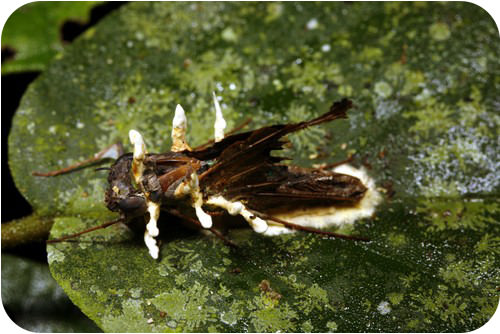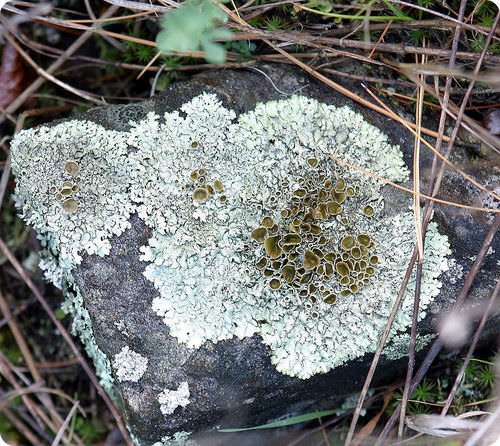8.5: Fungi Symbiosis
- Page ID
- 12207
\( \newcommand{\vecs}[1]{\overset { \scriptstyle \rightharpoonup} {\mathbf{#1}} } \)
\( \newcommand{\vecd}[1]{\overset{-\!-\!\rightharpoonup}{\vphantom{a}\smash {#1}}} \)
\( \newcommand{\dsum}{\displaystyle\sum\limits} \)
\( \newcommand{\dint}{\displaystyle\int\limits} \)
\( \newcommand{\dlim}{\displaystyle\lim\limits} \)
\( \newcommand{\id}{\mathrm{id}}\) \( \newcommand{\Span}{\mathrm{span}}\)
( \newcommand{\kernel}{\mathrm{null}\,}\) \( \newcommand{\range}{\mathrm{range}\,}\)
\( \newcommand{\RealPart}{\mathrm{Re}}\) \( \newcommand{\ImaginaryPart}{\mathrm{Im}}\)
\( \newcommand{\Argument}{\mathrm{Arg}}\) \( \newcommand{\norm}[1]{\| #1 \|}\)
\( \newcommand{\inner}[2]{\langle #1, #2 \rangle}\)
\( \newcommand{\Span}{\mathrm{span}}\)
\( \newcommand{\id}{\mathrm{id}}\)
\( \newcommand{\Span}{\mathrm{span}}\)
\( \newcommand{\kernel}{\mathrm{null}\,}\)
\( \newcommand{\range}{\mathrm{range}\,}\)
\( \newcommand{\RealPart}{\mathrm{Re}}\)
\( \newcommand{\ImaginaryPart}{\mathrm{Im}}\)
\( \newcommand{\Argument}{\mathrm{Arg}}\)
\( \newcommand{\norm}[1]{\| #1 \|}\)
\( \newcommand{\inner}[2]{\langle #1, #2 \rangle}\)
\( \newcommand{\Span}{\mathrm{span}}\) \( \newcommand{\AA}{\unicode[.8,0]{x212B}}\)
\( \newcommand{\vectorA}[1]{\vec{#1}} % arrow\)
\( \newcommand{\vectorAt}[1]{\vec{\text{#1}}} % arrow\)
\( \newcommand{\vectorB}[1]{\overset { \scriptstyle \rightharpoonup} {\mathbf{#1}} } \)
\( \newcommand{\vectorC}[1]{\textbf{#1}} \)
\( \newcommand{\vectorD}[1]{\overrightarrow{#1}} \)
\( \newcommand{\vectorDt}[1]{\overrightarrow{\text{#1}}} \)
\( \newcommand{\vectE}[1]{\overset{-\!-\!\rightharpoonup}{\vphantom{a}\smash{\mathbf {#1}}}} \)
\( \newcommand{\vecs}[1]{\overset { \scriptstyle \rightharpoonup} {\mathbf{#1}} } \)
\( \newcommand{\vecd}[1]{\overset{-\!-\!\rightharpoonup}{\vphantom{a}\smash {#1}}} \)
\(\newcommand{\avec}{\mathbf a}\) \(\newcommand{\bvec}{\mathbf b}\) \(\newcommand{\cvec}{\mathbf c}\) \(\newcommand{\dvec}{\mathbf d}\) \(\newcommand{\dtil}{\widetilde{\mathbf d}}\) \(\newcommand{\evec}{\mathbf e}\) \(\newcommand{\fvec}{\mathbf f}\) \(\newcommand{\nvec}{\mathbf n}\) \(\newcommand{\pvec}{\mathbf p}\) \(\newcommand{\qvec}{\mathbf q}\) \(\newcommand{\svec}{\mathbf s}\) \(\newcommand{\tvec}{\mathbf t}\) \(\newcommand{\uvec}{\mathbf u}\) \(\newcommand{\vvec}{\mathbf v}\) \(\newcommand{\wvec}{\mathbf w}\) \(\newcommand{\xvec}{\mathbf x}\) \(\newcommand{\yvec}{\mathbf y}\) \(\newcommand{\zvec}{\mathbf z}\) \(\newcommand{\rvec}{\mathbf r}\) \(\newcommand{\mvec}{\mathbf m}\) \(\newcommand{\zerovec}{\mathbf 0}\) \(\newcommand{\onevec}{\mathbf 1}\) \(\newcommand{\real}{\mathbb R}\) \(\newcommand{\twovec}[2]{\left[\begin{array}{r}#1 \\ #2 \end{array}\right]}\) \(\newcommand{\ctwovec}[2]{\left[\begin{array}{c}#1 \\ #2 \end{array}\right]}\) \(\newcommand{\threevec}[3]{\left[\begin{array}{r}#1 \\ #2 \\ #3 \end{array}\right]}\) \(\newcommand{\cthreevec}[3]{\left[\begin{array}{c}#1 \\ #2 \\ #3 \end{array}\right]}\) \(\newcommand{\fourvec}[4]{\left[\begin{array}{r}#1 \\ #2 \\ #3 \\ #4 \end{array}\right]}\) \(\newcommand{\cfourvec}[4]{\left[\begin{array}{c}#1 \\ #2 \\ #3 \\ #4 \end{array}\right]}\) \(\newcommand{\fivevec}[5]{\left[\begin{array}{r}#1 \\ #2 \\ #3 \\ #4 \\ #5 \\ \end{array}\right]}\) \(\newcommand{\cfivevec}[5]{\left[\begin{array}{c}#1 \\ #2 \\ #3 \\ #4 \\ #5 \\ \end{array}\right]}\) \(\newcommand{\mattwo}[4]{\left[\begin{array}{rr}#1 \amp #2 \\ #3 \amp #4 \\ \end{array}\right]}\) \(\newcommand{\laspan}[1]{\text{Span}\{#1\}}\) \(\newcommand{\bcal}{\cal B}\) \(\newcommand{\ccal}{\cal C}\) \(\newcommand{\scal}{\cal S}\) \(\newcommand{\wcal}{\cal W}\) \(\newcommand{\ecal}{\cal E}\) \(\newcommand{\coords}[2]{\left\{#1\right\}_{#2}}\) \(\newcommand{\gray}[1]{\color{gray}{#1}}\) \(\newcommand{\lgray}[1]{\color{lightgray}{#1}}\) \(\newcommand{\rank}{\operatorname{rank}}\) \(\newcommand{\row}{\text{Row}}\) \(\newcommand{\col}{\text{Col}}\) \(\renewcommand{\row}{\text{Row}}\) \(\newcommand{\nul}{\text{Nul}}\) \(\newcommand{\var}{\text{Var}}\) \(\newcommand{\corr}{\text{corr}}\) \(\newcommand{\len}[1]{\left|#1\right|}\) \(\newcommand{\bbar}{\overline{\bvec}}\) \(\newcommand{\bhat}{\widehat{\bvec}}\) \(\newcommand{\bperp}{\bvec^\perp}\) \(\newcommand{\xhat}{\widehat{\xvec}}\) \(\newcommand{\vhat}{\widehat{\vvec}}\) \(\newcommand{\uhat}{\widehat{\uvec}}\) \(\newcommand{\what}{\widehat{\wvec}}\) \(\newcommand{\Sighat}{\widehat{\Sigma}}\) \(\newcommand{\lt}{<}\) \(\newcommand{\gt}{>}\) \(\newcommand{\amp}{&}\) \(\definecolor{fillinmathshade}{gray}{0.9}\)
Do all fungi feed only on dead organisms?
Not all. This fungus is a lichen, providing nutrients to the tree. The lichen gets sugars from the plant. Both benefit from this relationship.
Symbiotic Relationships of Fungi
Not all fungi feed on dead organisms. Many are involved in symbiotic relationships, including parasitism and mutualism.
Fungi as Parasites
In a parasitic relationship, the parasite benefits while the host is harmed. Parasitic fungi live in or on other organisms and get their nutrients from them. Fungi have special structures for penetrating a host. They also produce enzymes that break down the host’s tissues.
Parasitic fungi often cause illness and may eventually kill their host. They are the major cause of disease in agricultural plants. Fungi also parasitize animals, such as the insect pictured in Figure below. Fungi even parasitize humans. Did you ever have athelete’s foot? If so, you were the host of a parasitic fungus.
 Parasitic Fungus and Insect Host. The white parasitic fungus named Cordyceps is shown here growing on its host—a dark brown moth.
Parasitic Fungus and Insect Host. The white parasitic fungus named Cordyceps is shown here growing on its host—a dark brown moth.Mutualism in Fungi
Fungi have several mutualistic relationships with other organisms. In mutualism, both organisms benefit from the relationship. Two common mutualistic relationships involving fungi are mycorrhiza and lichen.
- A mycorrhiza is a mutualistic relationship between a fungus and a plant. The fungus grows in or on the plant roots. The fungus benefits from the easy access to food made by the plant. The plant benefits because the fungus puts out mycelia that help absorb water and nutrients. Scientists think that a symbiotic relationship such as this may have allowed plants to first colonize the land.
- A lichen is an organism that results from a mutualistic relationship between a fungus and a photosynthetic organism. The other organism is usually a cyanobacterium or green alga. The fungus grows around the bacterial or algal cells. The fungus benefits from the constant supply of food produced by the photosynthesizer. The photosynthesizer benefits from the water and nutrients absorbed by the fungus. Figure below shows lichen growing on a rock.
 Lichen Growing on Rock. Unlike plants, lichen can grow on bare rocks because they don’t have roots. That’s why lichens are often pioneer species in primary ecological succession. How do lichen get water and nutrients without roots?
Lichen Growing on Rock. Unlike plants, lichen can grow on bare rocks because they don’t have roots. That’s why lichens are often pioneer species in primary ecological succession. How do lichen get water and nutrients without roots?Some fungi have mutualistic relationships with insects. For example:
- Leafcutter ants grow fungi on beds of leaves in their nests. The fungi get a protected place to live. The ants feed the fungi to their larvae.
- Ambrosia beetles bore holes in tree bark and “plant” fungal spores in the holes. The holes in the bark give the fungi an ideal place to grow. The beetles harvest fungi from their “garden.”
Summary
- Many fungi are involved in symbiotic relationships.
- Some fungi are parasites. They are specialized to penetrate a host and break down the host’s tissues. Parasitic fungi often cause illness and may eventually kill their host.
- Two common mutualistic relationships involving fungi are mycorrhiza (fungi and plant roots) and lichen (fungi and either cyanobacteria or green algae).
- Some fungi also have mutualistic relationships with insects.
Review
- How significant are fungi as plant parasites?
- Describe an example of a mutualistic relationship between fungi and insects.
- Assume that you notice a fungus growing on a plant. What possible relationships might exist between the fungus and the plant? What type of evidence might help you identify which is the correct relationship?
- Compare and contrast mycorrhiza and lichen.
| Image | Reference | Attributions |
 |
[Figure 1] | License: CC BY-NC |
 |
[Figure 2] | Credit: Image copyright Dr. Morley Read, 2014 Source: http://www.shutterstock.com License: Used under license from Shutterstock.com |
 |
[Figure 3] | Credit: User:Hardyplants/Wikipedia Source: http://commons.wikimedia.org/wiki/File:Lichen_reproduction1.jpg License: Public Domain |

